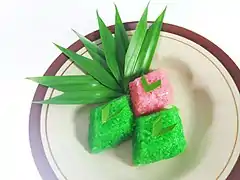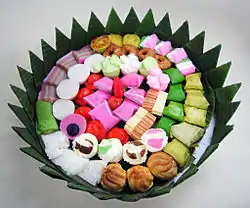Wajik
Wajik or wajid is an Indonesian diamond-shaped kue or traditional snack made with steamed glutinous (sticky) rice and further cooked in palm sugar, coconut milk, and pandan leaves.[1] The sweet sticky rice cake is commonly found in Indonesia, Malaysia and Brunei. It is called wajid in Brunei[2] and Sabah.
 Rhombus-shaped wajik | |
| Alternative names | Wajid |
|---|---|
| Type | Kue |
| Course | Snack |
| Place of origin | Indonesia[1] |
| Region or state | Java and Nationwide in Indonesia, also popular in Maritime Southeast Asia |
| Serving temperature | Room temperature |
| Main ingredients | Glutinous rice, palm sugar, coconut milk |
In Indonesian language the term wajik is used to describe the shape of rhombus or diamond-shape, consequently in a card game, the carreaux (tiles or diamonds♦) is translated as a wajik.
Ingredients and cooking method
Wajik is made with steamed glutinous (sticky) rice and further cooked in palm sugar, coconut milk, and pandan leaves. The cooked rice is then spread and flatted in a baking tray. Once it cools to room temperature, the sticky rice cake is cut into small pieces in the shape of a diamond or rhombus.[1]
Cultural significance
Wajik has a cultural significance within Javanese culture, as it often form an essential part in Javanese selamatan ceremony. During annual Sekaten festival, there is a Tumplak wajik ceremony. While in Pekalongan Regency there is a regional wajik specialty called Wajik Klethik.
References
- Anita (6 January 2014). "Wajik – Sticky Rice in Palm Sugar and Pandan Leaves". Daily Cooking Quest. Retrieved 19 June 2015.
- Tamara Thiessen (2012). Borneo: Sabah - Brunei - Sarawak. Bradt Travel Guides. pp. 146–. ISBN 978-1-84162-390-0. Retrieved 19 August 2013.
External links
 | Wet (basah) |
|
|---|---|---|
| Dry (kering) | ||
| Dishes |
| ||||||||||||||||||||||||||||||||||||||||||||||
|---|---|---|---|---|---|---|---|---|---|---|---|---|---|---|---|---|---|---|---|---|---|---|---|---|---|---|---|---|---|---|---|---|---|---|---|---|---|---|---|---|---|---|---|---|---|---|---|
| Snacks |
| ||||||||||||||||||||||||||||||||||||||||||||||
| Beverages |
| ||||||||||||||||||||||||||||||||||||||||||||||
| Bumbu |
| ||||||||||||||||||||||||||||||||||||||||||||||
| Influences and overseas dishes |
| ||||||||||||||||||||||||||||||||||||||||||||||
| List articles | |||||||||||||||||||||||||||||||||||||||||||||||
| Related topics | |||||||||||||||||||||||||||||||||||||||||||||||
| |||||||||||||||||||||||||||||||||||||||||||||||
| Common dishes | |||||
|---|---|---|---|---|---|
| Snacks |
| ||||
| Drinks | |||||
| |||||
| Common dishes |
| ||||||||||||
|---|---|---|---|---|---|---|---|---|---|---|---|---|---|
| Snacks |
| ||||||||||||
| Desserts |
| ||||||||||||
| Drinks |
| ||||||||||||
| Condiments | |||||||||||||
| |||||||||||||